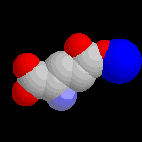"The flavor enhancing material, monosodium glutamate, has been produced commercially by chemical synthesis, by fermentation, and by the hydrolysis of naturally occurring substances. Glutamic acid exists in two different chemical forms: the L- and D-isomers and the DL-racemic mixture. It is the monosodium salt of the L-form, which has the power of augmenting the flavor of some foods. It has a faint salty flavor but draws out the subtle flavors of foods to which it is added. Early manufactured products were said to have a meat-like taste, but this is now known to have been caused by impurities." "Glutamic acid was first isolated in 1866 by the German chemist, Ritthausen, using acid hydrolysis of gliadin, a component of wheat gluten. In 1890 Wolff successfully synthesized glutamic acid using levulinic acid as the starting material. However, it was not until 1908 that the flavor-enhancing properties were noticed by Kikunae Ikeda of Tokyo, Japan. From the acid hydolysis of the dried seaweed, _laminaria_japonica_, he separated glutamic acid from the other amino acids, and by neutralizing with soda, obtained sodium glutamate. Saburosuka Suzuki and Company of Tokyo (now Ajinomoto Co., Inc.) were the first to produce monosodium glutamate commercially using the hydrolysis of wheat gluten and extracted soybean meal; it was sold under the trademark AJI-NO-MOTO. The Huron milling company of Harbor Beach, Michigan, first attempted to produce glutamate from wheat gluten in the United States."
 "It has long been known that various microbiological organisms produce amino acids in their life processes, and the metabolism of amino acids has been intensively studied in recent decades. The first extracellular accumulation of large quantities of glutamic acid was achieved in 1956 at Kyowa Fermentation Company, Ltd., of Japan and at the University of Tokyo. Studies were advanced utilizing various substrates. Yeasts, molds, and bacteria were tried in the attempt to find a strain which would accumulate amino acids, and particularly glutamic acid, in large quantities. From carbohydrate substrates, bacteria are far more useful than either molds or yeasts for glutamic acid accumulation." "Today, most of the world's production of monosodium glutamate is by fermentation. Production from Steffen waste and other sources has practically ceased. Sources of carbonaceous starting material cheaper than molasses are being sought in the petroleum field." IS MSG ARTIFICIAL? MSG is a completely natural chemical. It exists in every cell of your body. It is a necessary chemical for making protein. Without MSG, you would die. HOW DO I KNOW IF I'M ALLERGIC TO MSG? Simple. You're not. If you were allergic to MSG, you wouldn't have survived infancy. Being allergic to MSG is like being allergic to oxygen, water, or salt. People who say they're allergic to MSG are either hypochondriacs or they don't understand what an allergy is. This is not to say some people aren't sensitive to MSG. I myself am MSG-sensitive. When overdosed with MSG, I get all hot and red and sweat a lot. But this seems to be the result of a large overdose. In my own experiments, I've eaten up to a quarter-teaspoon in a short period of time with no ill effect. That's about a gram! I've only gotten the infamous "Chinese Restaurant Syndrome" in actual restaurants. I don't know how much MSG they use, but it must be a lot! Note that MSG costs about $0.70 for a half-pound bag. It's almost as cheap as sugar. No wonder parsimonious Chinese chefs wantonly throw it around, to save costs on real food. Good thing cornstarch doesn't cause the same symptoms. what it does to people, and why so many people are allergic to it.
"It has long been known that various microbiological organisms produce amino acids in their life processes, and the metabolism of amino acids has been intensively studied in recent decades. The first extracellular accumulation of large quantities of glutamic acid was achieved in 1956 at Kyowa Fermentation Company, Ltd., of Japan and at the University of Tokyo. Studies were advanced utilizing various substrates. Yeasts, molds, and bacteria were tried in the attempt to find a strain which would accumulate amino acids, and particularly glutamic acid, in large quantities. From carbohydrate substrates, bacteria are far more useful than either molds or yeasts for glutamic acid accumulation." "Today, most of the world's production of monosodium glutamate is by fermentation. Production from Steffen waste and other sources has practically ceased. Sources of carbonaceous starting material cheaper than molasses are being sought in the petroleum field." IS MSG ARTIFICIAL? MSG is a completely natural chemical. It exists in every cell of your body. It is a necessary chemical for making protein. Without MSG, you would die. HOW DO I KNOW IF I'M ALLERGIC TO MSG? Simple. You're not. If you were allergic to MSG, you wouldn't have survived infancy. Being allergic to MSG is like being allergic to oxygen, water, or salt. People who say they're allergic to MSG are either hypochondriacs or they don't understand what an allergy is. This is not to say some people aren't sensitive to MSG. I myself am MSG-sensitive. When overdosed with MSG, I get all hot and red and sweat a lot. But this seems to be the result of a large overdose. In my own experiments, I've eaten up to a quarter-teaspoon in a short period of time with no ill effect. That's about a gram! I've only gotten the infamous "Chinese Restaurant Syndrome" in actual restaurants. I don't know how much MSG they use, but it must be a lot! Note that MSG costs about $0.70 for a half-pound bag. It's almost as cheap as sugar. No wonder parsimonious Chinese chefs wantonly throw it around, to save costs on real food. Good thing cornstarch doesn't cause the same symptoms. what it does to people, and why so many people are allergic to it.
WHAT IS MSG? Quoting from _Beet-Sugar_Technology_ (2nd ed.) edited by R.A.McGinnis (Beet Sugar Development Foundation, 1971), pages 599-601:
かくしキャラ:グルタミン酸ソーダ